Ethiopia's economic narrative is as complex as it is fascinating. While often labeled among the poorest nations in Africa, there's more to this story than meets the eye. The country has faced tremendous challenges, from historical conflicts to modern-day economic hurdles, but it's also seen remarkable strides in development.
This article takes a closer look at Ethiopia's economic journey. We'll start with its historical context to understand where these perceptions stem from. Then, we'll delve into the pressing issues affecting its economy today, followed by the initiatives aimed at fostering growth. Finally, we'll explore what the future holds for Ethiopia and its potential to rise above its challenges.
- Historical Context and Economic Background
- Current Economic Challenges
- Growth and Development Initiatives
- Future Prospects and Opportunities
Historical Context and Economic Background
The economic history of Ethiopia is deeply rooted in a mosaic of ancient civilizations, empires, and diverse cultures. Known as one of the oldest nations in the world, Ethiopia's history is marked by a rich tapestry of cultural and economic heritage. The Kingdom of Aksum, dating back to approximately 100 AD, was a major trading empire known for its obelisks and early adoption of Christianity. This ancient civilization engaged in trade with countries as far as India and Rome, highlighting Ethiopia's early role in global commerce.
Despite its early prosperity, Ethiopia's economic progression was disrupted by a series of invasions, and internal conflicts. The 16th century saw incursions by the Ottoman Turks and neighboring sultanates, which significantly impacted the economic stability of the region. The advent of European colonial powers in Africa during the 19th century did not spare Ethiopia; however, it remained unique as one of the few African nations to resist colonization, successfully defeating the Italian army at the Battle of Adwa in 1896.
Moving into the 20th century, Ethiopia's economy experienced significant fluctuations. Emperor Haile Selassie, who ruled from 1930 to 1974, initiated various modernization efforts. However, the Italian occupation from 1936 to 1941 during World War II left the country's infrastructure in ruins. Post World War II, there was an attempt to rebuild and modernize but was hampered by political instability. The downfall of Haile Selassie's regime in 1974, followed by the Marxist Derg military junta, led to nationalization of land and industry, exacerbating economic troubles and leading to widespread famine in the 1980s.
The end of the Derg regime in 1991 marked a significant turning point. The new Ethiopian People's Revolutionary Democratic Front (EPRDF) government focused on market-oriented reforms and aligning with global financial institutions. Despite these efforts, Ethiopia was still grappling with poverty, with the economy heavily dependent on agriculture, which employed around 80% of the population. The erratic climate, coupled with recurring droughts, often led to food shortages and economic instability.
One noteworthy period in Ethiopia's recent history was the Ethio-Eritrean War from 1998 to 2000, which diverted crucial resources from economic development to military expenditure. The war not only strained the economic conditions but also displaced a significant portion of the population, creating a humanitarian crisis. The conflict between the two nations ended with the Algiers Agreement in 2000, but its economic repercussions were felt long after.
In the early 2000s, Ethiopia began to see steady economic growth, attributed to government investments in infrastructure, education, and healthcare. The Growth and Transformation Plans (GTP I & II) aimed at transforming the economic landscape by focusing on industrialization and expanding the service sector. International partnerships and foreign investments also started to play a significant role during this period, with China emerging as a major investor in Ethiopian infrastructure projects.
Despite these positive strides, Ethiopia remained burdened by its historical challenges. The legacy of political turmoil, combined with demographic pressures as one of Africa's most populous countries, posed challenges to sustainable economic development. As of the early 2020s, Ethiopia continued to grapple with issues such as unemployment, regional conflicts, and dependency on agriculture, which made the economy vulnerable to environmental changes.
"Ethiopia's history is a testament to resilience, but it also underscores the need for sustainable and inclusive economic strategies," says Dr. Berhanu Nega, a notable economist and politician.
Ethiopia's economic background reveals a nation that has always been at the crossroads of historical civilizations and modern economic aspirations. From ancient trade routes to contemporary geopolitical challenges, understanding Ethiopia's past provides a clear lens through which its current economic situation can be comprehended. As we delve deeper, the intricate balances between historical legacies and future aspirations become evident.
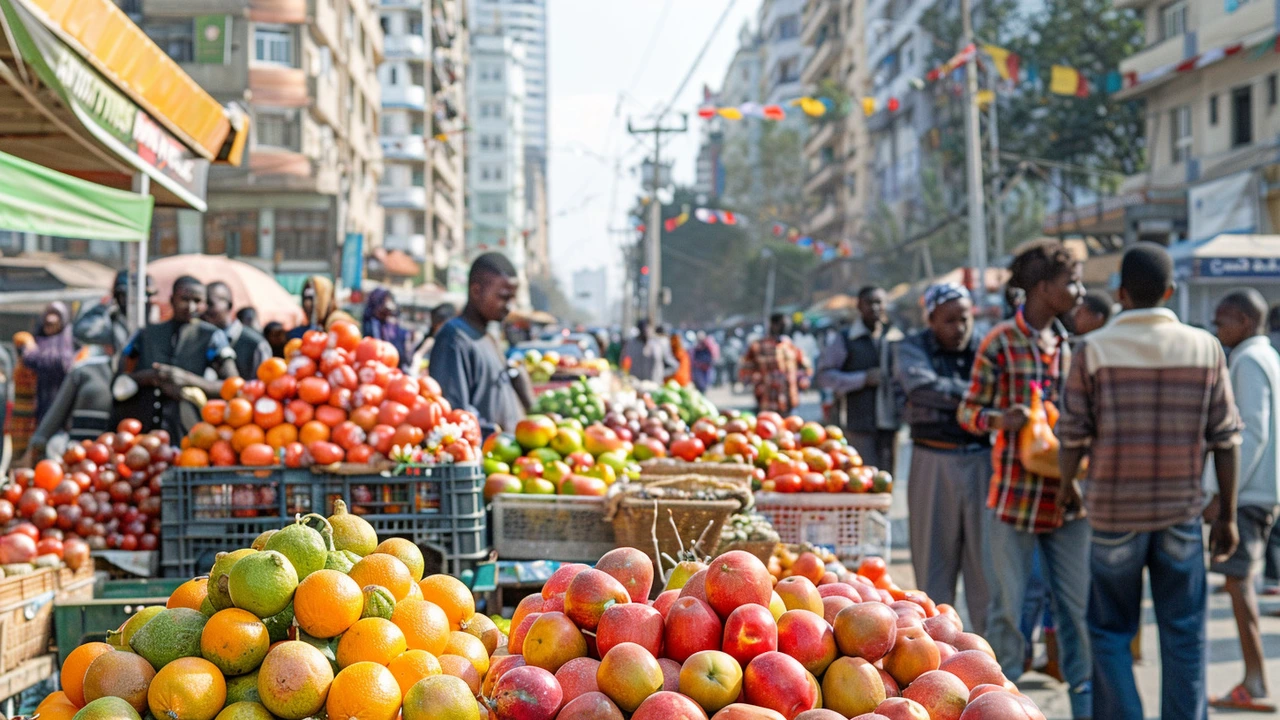
Current Economic Challenges
Despite Ethiopia's impressive strides in development, the country still grapples with significant economic challenges that impact the daily lives of its people. One of the most immediate issues is high inflation. Over the past few years, Ethiopia has experienced double-digit inflation rates, which erodes the purchasing power of ordinary citizens and makes it difficult for families to afford basic necessities. This inflationary pressure is partly due to the rapid depreciation of the Ethiopian birr and high dependency on imports.
Another pressing challenge is high unemployment, especially among the youth. Ethiopia's population is young, with over 70% under the age of 30. While this demographic presents a potential for economic growth, it also poses a risk if job creation does not keep pace with the growing labor force. Many graduates find themselves without job opportunities, leading to a sense of frustration and economic instability.
Agriculture remains the backbone of Ethiopia's economy, employing around 70% of the population. However, the sector is highly vulnerable to climate change and environmental degradation. Frequent droughts and erratic weather patterns have severely impacted agricultural productivity, leading to food shortages and price hikes. The reliance on rain-fed agriculture makes the rural population particularly susceptible to these changes.
Poverty is another critical issue, with about a quarter of the population living below the national poverty line. This is largely due to the uneven distribution of resources and services. Rural areas, in particular, suffer from a lack of infrastructure and basic services such as healthcare and education. This inequality perpetuates the cycle of poverty, making it hard for rural communities to break free from their economic hardships.
The political landscape also plays a significant role in Ethiopia's economic challenges. Political instability and ethnic conflicts have disrupted economic activities and deterred foreign investment. In recent years, the government has undertaken reforms to foster peace and stability, but the road to lasting peace is long and fraught with difficulties. Lasting peace is crucial for economic development, as it builds investor confidence and allows for sustainable growth.
Infrastructure deficits remain a problem. Despite significant investments in roads, railways, and energy projects, many parts of the country still lack adequate infrastructure. This deficit hampers economic activities and puts a drag on productivity. Efficient transport and reliable energy supply are essential for economic development, and addressing these gaps is critical for Ethiopia's growth.
According to the World Bank, "Addressing these challenges requires a multi-faceted approach that combines economic reforms, investments in infrastructure, and measures to promote social inclusion."
Healthcare and education systems in Ethiopia are still developing, and access to quality services is limited, particularly in the rural areas. Health issues such as malnutrition and infectious diseases persist, partly due to inadequate healthcare infrastructure. Education challenges also remain, with many children out of school and literacy rates needing improvement.
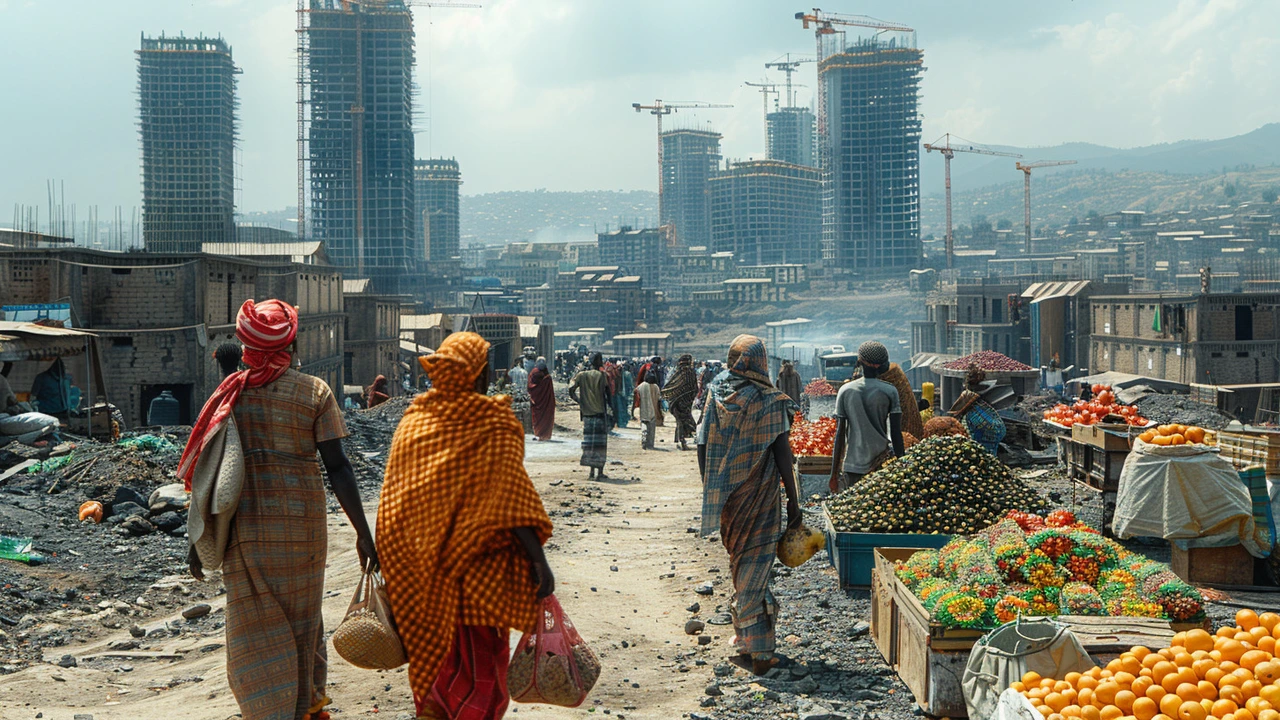
Growth and Development Initiatives
Over the past few decades, Ethiopia has embarked on a determined path toward economic growth and development. The government, along with international partners, has implemented various initiatives aimed at transforming the country’s economic landscape. A major catalyst for this drive has been the Growth and Transformation Plan (GTP), first launched in 2010. This comprehensive program has set ambitious targets for sectors ranging from agriculture to infrastructure.
Agriculture remains the backbone of Ethiopia’s economy, and significant investments have been made to modernize this sector. The government has launched programs to introduce irrigation techniques, improve seed quality, and provide better access to farming tools. These efforts are aimed at boosting productivity and ensuring food security. Additionally, the development of agro-industrial parks is helping to promote value addition, creating jobs and facilitating export growth.
Infrastructure development is another key focus. The construction of the Grand Ethiopian Renaissance Dam (GERD) is a prime example of Ethiopia’s commitment to energy production. Once completed, this dam is expected to provide electricity to millions of Ethiopians and export surplus energy to neighboring countries. Improved energy access is essential for industrial growth and enhancing the quality of life for citizens.
The transportation sector has also seen marked improvements. The expansion of road networks and the development of a modern railway system, such as the Addis Ababa-Djibouti Railway, are crucial for connecting different regions and facilitating trade. These projects not only make it easier for goods to move across the country but also help integrate rural areas into the national economy.
According to the World Bank, "The expansion of infrastructure in Ethiopia is contributing significantly to economic growth and poverty reduction."
In the education and health sectors, Ethiopia is making strides. The government has invested in building schools and hospitals, training teachers and healthcare professionals, and improving access to essential services. These investments aim to foster a healthier and more educated population, thus providing a solid foundation for sustained economic growth.
Another significant initiative is the promotion of foreign direct investment (FDI). The creation of industrial parks has attracted numerous multinational companies to set up factories in Ethiopia. These parks offer incentives such as tax breaks and expedited services to investors, encouraging more FDI and boosting the manufacturing sector. The Hawassa Industrial Park, for instance, has become a hub for textile and apparel production, creating thousands of jobs and contributing to export revenues.
Digitalization is also gaining ground. The Ethiopian government recognizes the importance of technology in driving modern economies. Efforts to improve internet connectivity, promote digital literacy, and support tech startups are part of Ethiopia's broader strategy to build a knowledge-based economy. Programs like the Ethiopia Digital Foundation Project aim to enhance digital access across the nation, facilitating innovation and entrepreneurship.
These diverse initiatives underscore the multifaceted approach Ethiopia is taking to overcome its economic challenges. While the road to prosperity is still long and filled with obstacles, the ongoing efforts show promising signs of progress. The continuous support from international organizations and the resilience of the Ethiopian people play crucial roles in this journey.
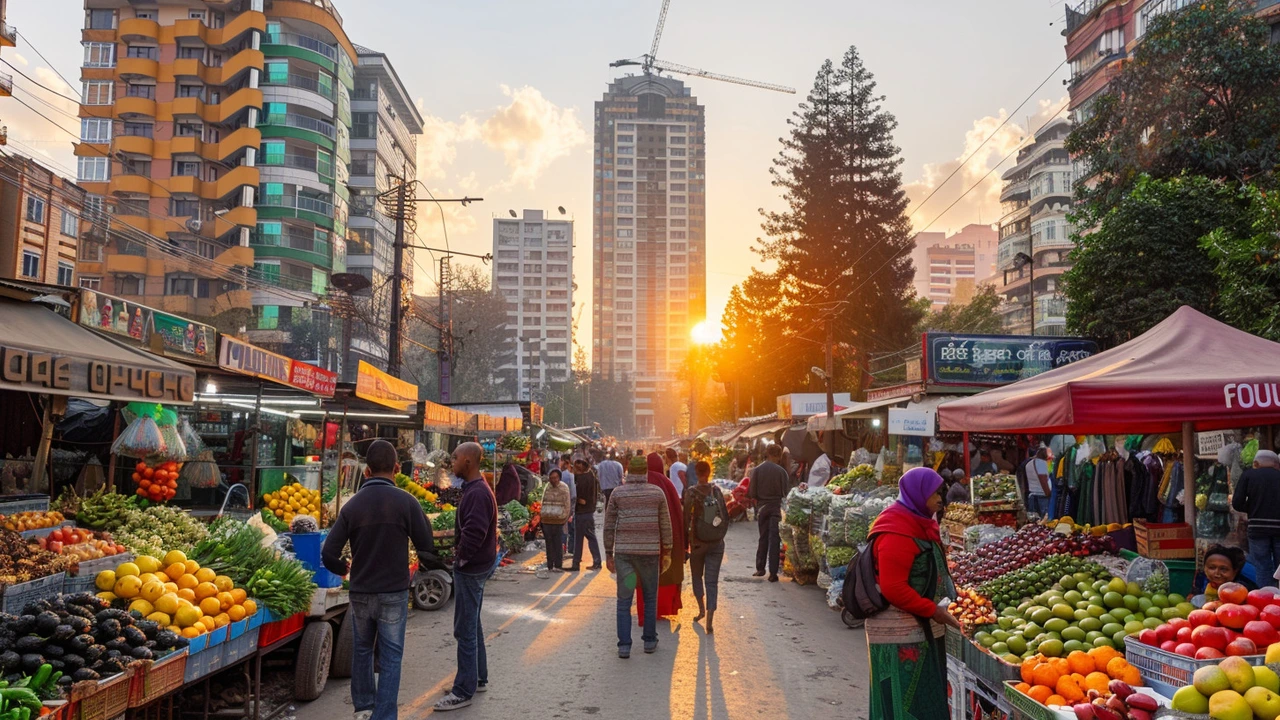
Future Prospects and Opportunities
The future of Ethiopia's economy holds both challenges and immense potential. One of the key factors that could dramatically reshape the country's economic trajectory is its youthful population. Ethiopia's demographics are incredibly youthful, with almost 70% of its population under the age of 30. This can be a significant boon if leveraged correctly through investments in education, skill development, and job creation.
Another promising area is the agricultural sector. Agriculture remains the backbone of Ethiopia's economy, employing around 80% of the population. Innovations in agricultural technology and sustainable farming practices could radically enhance productivity, ensuring food security and generating surplus for export. Initiatives like the Agricultural Transformation Agenda aim to modernize farming methods, improve market linkages, and enhance value chains. Government collaboration with international organizations to support rural farmers with training and resources is a step in the right direction.
Infrastructure development also presents substantial opportunities. Ethiopia has been investing heavily in infrastructure, from road networks to energy projects. The construction of the Grand Ethiopian Renaissance Dam (GERD) is one of the most ambitious infrastructure projects in Africa. With an expected capacity of over 6,000 MW, it could significantly boost the country's energy supply, fostering industrial growth and attracting foreign investors.
The World Bank noted, "Ethiopia's focus on human capital and infrastructure development could set the foundation for sustained economic growth, provided that reforms continue to address structural challenges."
Moreover, Ethiopia's growing textile and apparel industry shows promise as a driver for economic diversification. With its relatively low labor costs and favorable climate for cotton production, the nation has the potential to become a significant player in the global textile market. The government's push to create industrial parks focusing on textile manufacturing has already started to attract foreign companies looking for new production bases outside of Asia.
Tourism also holds untapped potential. Ethiopia, rich in historical sites, diverse cultures, and breathtaking landscapes, is an emerging tourist destination. Initiatives to improve tourism infrastructure and promote the country's unique heritage could bring substantial revenue, supporting local economies and creating jobs. The country’s historical treasures, including Lalibela's rock-hewn churches and the ancient city of Axum, as well as astonishing natural wonders like the Simien Mountains, have begun to draw increasing numbers of international visitors.
Furthermore, the digital economy is another promising frontier. The mobile revolution in Africa has not bypassed Ethiopia, and there's a growing appetite for digital services. The recent liberalization of the telecom sector with the introduction of new players is set to boost connectivity and digital inclusion. Tech hubs and startups are popping up, driven by a youthful population eager to innovate. Investments in the tech sector could spur new industries, generate employment, and contribute significantly to GDP growth.
Yet, realizing these opportunities will require overcoming persistent challenges. Political stability and good governance are critical. Recent history has shown that political tensions can derail economic progress. Ongoing efforts for political reforms, peacebuilding, and inclusive governance are essential for sustainable development. Economic policies must also ensure the equitable distribution of resources to reduce poverty and bridge the urban-rural divide.
International partnerships and foreign aid can play a supportive role, but the ultimate key will be homegrown solutions tailored to Ethiopia's unique circumstances. Emphasizing inclusive growth and fostering a resilient economy are paramount for Ethiopia to emerge stronger and more prosperous. Engaging the private sector, empowering communities, and maintaining a stable political environment will be vital as the country navigates its path forward. The potential for Ethiopia to overcome its economic hurdles and leap forward is tangible, given the right strategic vision and commitment to sustainable development.
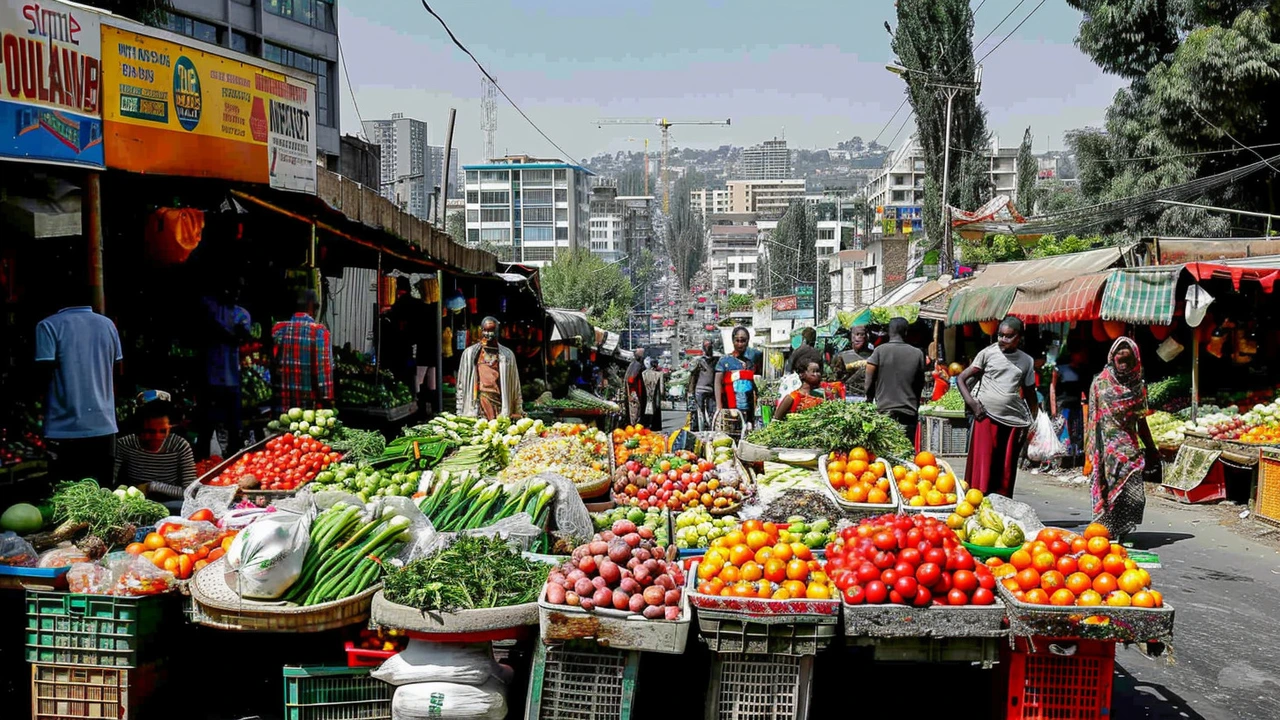
 Exploring the Major Occupation in Ethiopia: The Agricultural Backbone
Exploring the Major Occupation in Ethiopia: The Agricultural Backbone
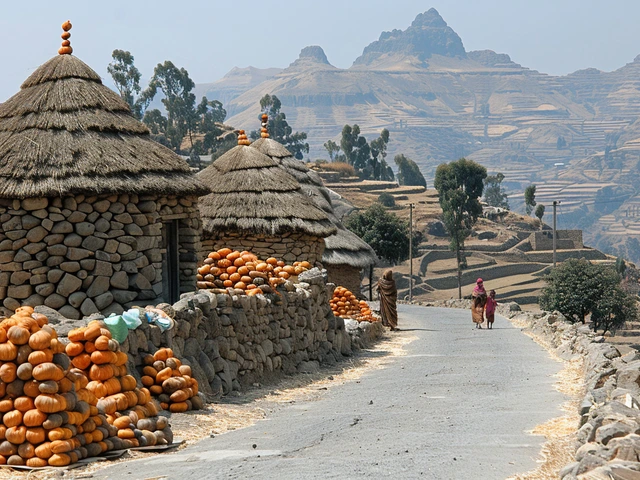 Understanding Poverty in Ethiopia: Facts and Insights
Understanding Poverty in Ethiopia: Facts and Insights
 Understanding Ethiopia's Economic Challenges: Reasons Behind its Low Income Status
Understanding Ethiopia's Economic Challenges: Reasons Behind its Low Income Status
 How to Open a PayPal Account in Ethiopia: A Step-by-Step Guide
How to Open a PayPal Account in Ethiopia: A Step-by-Step Guide
 Making Money on YouTube in Ethiopia: A Practical Guide
Making Money on YouTube in Ethiopia: A Practical Guide
Sherri Gassaway
June 1, 2024 AT 17:35When one reads the economic chronicles of Ethiopia, the narrative feels less like a ledger of numbers and more like a tapestry woven with threads of resilience and turmoil. The centuries of empire, colonization attempts, and internal strife have left imprints that shape today's fiscal landscape. It is as if the country's GDP is a mirror reflecting not just market forces but also the echoes of ancient trade routes. In this light, labeling Ethiopia simply as "poor" obscures the depth of its historical endurance. Perhaps we ought to consider wealth beyond monetary metrics, recognizing the cultural and intellectual capital that persists despite hardship.
Milo Cado
June 8, 2024 AT 07:18Excellent reflection, Sherri! Your philosophical framing truly captures the nuance behind the statistics. It’s encouraging to see such depth, especially when the discourse often reduces complex realities to simple numbers. Let’s keep highlighting these layers-progress is a mosaic, not a single shade. 🎉
MONA RAMIDI
June 14, 2024 AT 21:01Honestly, this whole "rise above challenges" narrative feels like a fairy‑tale written for tourists.
grace riehman
June 21, 2024 AT 10:44Hey, i get where you're comin from but the cultural heritage in Ethiopia is real-like the rock hewn churches and the coffee origins-they add value that you cant put on a spreadsheet. Its defnitely more than just a "fairy‑tale" when you consider the human stories behind the data.
Vinay Upadhyay
June 28, 2024 AT 00:27Wow, another “optimistic” piece that glosses over the structural flaws. It’s amusing how the author sprinkles in buzzwords like “growth” while ignoring the glaring fiscal deficits and the unsustainable debt‑to‑GDP ratio. One would expect a more rigorous analysis given the glaring inflation rates, yet we get a love‑letter to development. Sarcastically, perhaps the real challenge is convincing readers that optimism alone can offset macro‑economic mismanagement.
Eve Alice Malik
July 4, 2024 AT 14:10Your take on the debt issue is spot on. Adding to that, the recent reforms in the telecom sector could actually help diversify revenue streams, provided the regulatory environment remains stable. It's a small step, but it might lay groundwork for more sustainable growth in the long run.
Debbie Billingsley
July 11, 2024 AT 03:53It is imperative to recognize that Ethiopia’s sovereignty and national pride have often been undermined by external economic pressures; defending our own resources is not just a policy choice but a patriotic duty.
Patrick Van den Berghe
July 17, 2024 AT 17:35True but the data says ignoring external investment hurts too
Josephine Gardiner
July 24, 2024 AT 07:18Observing the recent infrastructural initiatives, one notes a measured pace that balances ambition with realistic capacity constraints. Such a methodical approach may serve as a stabilizing factor for the broader economy.
Jordan Fields
July 30, 2024 AT 21:01The pace appears appropriate given current fiscal parameters.
Divyaa Patel
August 6, 2024 AT 10:44The Ethiopian saga is a kaleidoscope of triumphs and tribulations, each hue illuminating a distinct facet of human perseverance. From the ancient corridors of Aksum’s stone obelisks to the bustling markets of Addis Ababa, history whispers of a legacy that refuses to be eclipsed by mere statistics. One might argue that wealth cannot be shackled to GDP alone, for the soul of a nation thrives in its stories, its art, its unyielding spirit. The relentless march of modernization, embodied by the grandiose vision of the GERD, is not just a feat of engineering but a testament to collective aspiration. Yet, the shadows of drought‑scarred fields linger, reminding us that nature’s caprice remains a formidable adversary. When the monsoon fails, the agrarian backbone quivers, and with it, the livelihoods of countless families. This paradox-of soaring potential juxtaposed with endemic vulnerability-paints a portrait of resilience tinged with fragility. The youthful demographic, teeming with vigor, is a double‑edged sword; it heralds a vibrant workforce, yet also underscores the urgency for job creation. Education, the lantern that can guide this demographic, must be fortified, for without knowledge the flame of progress dims. Infrastructure projects, from railways to roads, are the arteries through which commerce flows, yet they demand sustained maintenance and thoughtful integration. The digital revolution, though nascent, offers a beacon of possibility, promising to bridge gaps that geography once imposed. However, the specter of political volatility looms, threatening to fray the delicate tapestry of reform. Ethnic tensions, if left unaddressed, could erode the hard‑won gains of the past decade. International partnerships, while invaluable, must be navigated with sovereignty in mind, ensuring that aid fuels empowerment rather than dependence. The entrepreneurial spirit bubbling in tech hubs signals a nascent shift toward a knowledge‑based economy, a shift that could redefine Ethiopia’s global standing. Yet, each stride forward is contingent upon inclusive policies that uplift even the most remote villages. Climate adaptation strategies, such as irrigation and drought‑resilient crops, are not optional-they are existential imperatives. In summation, Ethiopia stands at a crossroads where destiny is not preordained but crafted through deliberate, compassionate action. The future beckons with promise, but only if the chorus of voices-farmers, scholars, engineers, and activists-sings in harmonious resolve.
Larry Keaton
August 13, 2024 AT 00:27Yo Divyaa, that was a heck of a deep dive! I totally vibe with the point about the youth being both a blessing and a pressure cooker – we gotta keep the schools and tech spots poppin'. Also, love how you highlighted the climate stuff – without that, the whole thing could fall apart. Keep dropping those insights, it helps us all see the bigger picture.
Liliana Carranza
August 19, 2024 AT 14:10Stay hopeful, everyone! Every small step toward education and clean energy fuels a brighter tomorrow.
Jeff Byrd
August 26, 2024 AT 03:53Sure thing, Liliana – because optimism is a full‑time job that pays in sheer delusion. 🙃
Joel Watson
September 1, 2024 AT 17:35While the aforementioned perspectives offer a commendable overview, one must recognize that true intellectual discourse demands a rigorous analytical framework, an approach often absent in mainstream narratives.